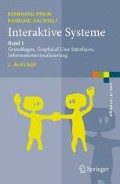Zusammenfassung
Die historische Entwicklung von Benutzungsschnittstellen ist aus verschiedenen Gründen aufschlussreich: Es wird deutlich, dass viele Interaktionsformen, die uns heute als selbstverständlich erscheinen, das Ergebnis eines Prozesses sind, in dessen Verlauf oft andere Alternativen bestanden haben. Die Geschichte zeigt auch, welche Motivation hinter verschiedenen Entwicklungen steckt. Die Auswahl der in diesem Kapitel betrachteten Aspekte ist von diesen didaktischen Überlegungen geleitet.
Access this chapter
Tax calculation will be finalised at checkout
Purchases are for personal use only
Preview
Unable to display preview. Download preview PDF.
Literaturverzeichnis
Griffin, S. (2010). ibiblio: ibiblio.org the public’s library and digital archive, 2010. URL http://www.ibiblio.org/pioneers/index.html. besucht am 18. Juni 2010.
Apple (1987). Apple Human Interface Guidelines: The AppleDesktop Interface. Addison Wesley, Reading, Massachusetts.
Williams, G. (1984). The apple macintosh computer. Byte, 9 (2): 30–54.
Baecker, R. M., Grudin, J., Buxton, W. A. S., Greenberg, S. (1995). Readings in Human Computer Interaction: Towards the Year 2000. Morgan Kaufman, San Francisco, 2 edition.
Teitelman, W. (1979). A display oriented programmers assistant. International Journal of Man-Machine Studies, 11:157–187.
Buxton, B. (2007). Sketching the User Experience: Getting the Design Right and the Right Design. Morgan Kaufman.
Card, S. K., Newell, A., Moran, T. P. (1983). The psychology of human computer interaction. Lawrence, Erlbaum Associates.
Alby, T. (2007). Web 2.0. Konzepte, Anwendungen, Technologien. Hanser Verlag, 2 edition.
Tesler, L. (1981). The smalltalk environment. Byte, 6(8): 90–147.
Wurster, C. (2002). Computer – Eine illustrierte Geschichte. Taschen, Köln.
Simpson, R., Renear, A., Mylonas, E., van Dam, A. (1996). 50 years after - as we may think: The brown/mit vannevar bush symposium. interactions, 3(2): 47–67.
Elrod, S., Bruce, R., Gold, R., Goldberg, D., Halasz, F. and Janssen, W. (1992). Liveboard: a large interactive display supporting group meetings, presentations, and remote collaboration. In Proc. of the ACM SIGCHI conference on Human factors in computing systems, S. 599–607.
Hender, J., Dean, D., Rodgers, T., Nunamaker Jr, J. (2001). Improving group creativity: Brainstorming versus non-brainstorming techniques in a gss environment. In HICSS ’01: Proc. of the 3Hawaii International Conference on System Sciences (HICSS-34)-Volume 1, S. 1067, Washington, DC, USA. IEEE Computer Society.
Maes, P. (1997). Agents that Reduce Work and Information Overload. AAAI Press/MIT Press.
Johnson, J., Roberts, T., Verplank, W., Smith, D. C., Irby, C. H., Beard, M., Mackey, K. (1989). The xerox star: A retrospecitve. IEEE Computer, 22(9):11–29.
Smith, D. C., Irby, C., Kimpball, R., Verplank, W., Harslam, E. (1982). Designing the star user interface. Byte, 7(4): 242–282.
IBM (1991). Systems Application Architecture/ Common User Access Guide to User Interface Design. IBM. ISBN SC34-4289-00.
Nelson, T. (1973). A conceptual framework for man-machine everything. Proc. of National Computer Conference, S. 21–26.
Licklider, J. C. R. (1960). Man-computer symbiosis. IRE Trans. on Human Factors in Electronics HFE, 1(1):4–11.
Knowlton, K. (1966). Computer-produced movies. Science, 150:1116–1120.
Kay, A. C. (1996). chapter The early history of Smalltalk, S. 511–598. ACM, New York, NY, USA.
Nelson, T. (1965). A file structure for the complex, the changing and the indeterminate. In Proc. of the ACM National Conference, S. 84–100.
Johnson, T. (1963). Sketch-pad iii: Three-dimensional graphics communication with a digital computer. AFIPS Conference Proceedings, 23:347–353.
Levinthal, C. (1966). Molecular model-building by computers. Scientific American, 214(6):42–52.
Klingert, A. (1996). Einführung in Graphische Fenstersysteme. Springer Verlag Berlin.
Stotz, R. (1963). Man-machine console facilities for computer-aided design. In AFIPS Conference Proceedings, S. 323–338.
Myers, B. (1998). A brief history of human computer interaction technology. interactions, 5(2):44–54.
Weiser, M. (1991). The computer for the 21st century. Scientific American, S. 94–104.
Sutherland, I. E. (1963). Sketchpad, a man-machine graphical communication system. In AFIPS Conference Proceedings, volume 23, S. 629–636.
Kay, A. C. (1972). A personal computer for children of all ages. In Proc. of the ACM National Conference, Boston, CA.
Berners-Lee, T., Cailliau, R., Luotonen, A., Nielsen, H. F. and Secret, A. (1994). The world-wide web. Communications of the ACM, 37(8):76–82.
Author information
Authors and Affiliations
Corresponding author
Rights and permissions
Copyright information
© 2010 Springer-Verlag Berlin Heidelberg
About this chapter
Cite this chapter
Preim, B., Dachselt, R. (2010). Historische Entwicklung. In: Interaktive Systeme. eXamen.press. Springer, Berlin, Heidelberg. https://doi.org/10.1007/978-3-642-05402-0_5
Download citation
DOI: https://doi.org/10.1007/978-3-642-05402-0_5
Published:
Publisher Name: Springer, Berlin, Heidelberg
Print ISBN: 978-3-642-05401-3
Online ISBN: 978-3-642-05402-0
eBook Packages: Computer Science and Engineering (German Language)

